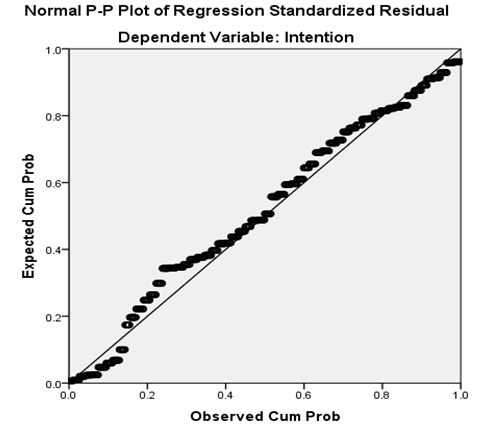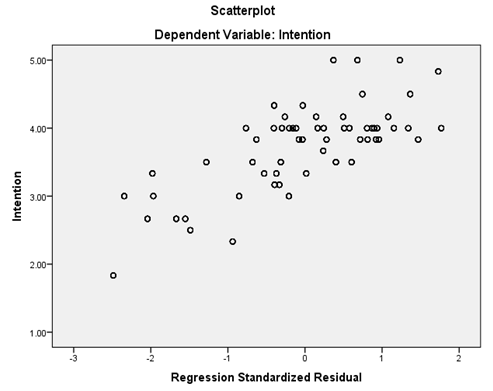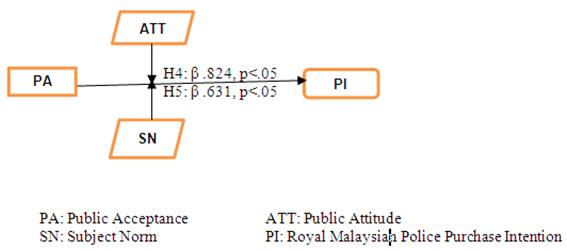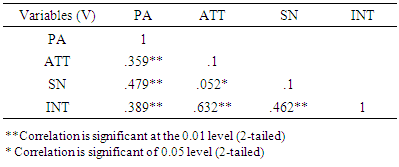-
Paper Information
- Next Paper
- Previous Paper
- Paper Submission
-
Journal Information
- About This Journal
- Editorial Board
- Current Issue
- Archive
- Author Guidelines
- Contact Us
International Journal of Advanced and Multidisciplinary Social Science
2017; 3(1): 7-14
doi:10.5923/j.jamss.20170301.02

Public Acceptance on Saving Lives Using Taser for Royal Malaysian Police
Selvarajah Krishnan1, Roger Tan Chai Wha2
1International University of Malaya-Wales, Kuala Lumpur, Malaysia
2Pro ICE, Malaysia
Correspondence to: Selvarajah Krishnan, International University of Malaya-Wales, Kuala Lumpur, Malaysia.
| Email: |  |
Copyright © 2017 Scientific & Academic Publishing. All Rights Reserved.
This work is licensed under the Creative Commons Attribution International License (CC BY).
http://creativecommons.org/licenses/by/4.0/

Crime is a menace to our society and pose a huge challenge to our law enforcers and society at large. It had taken a toll on valuable resources, slowed down productivity, and destroyed lives, threatened prosperity, created uncertainty and fear in every level of society. Incorrectly or mistakenly weapons often spelt trouble for the law enforcers as enshrine in Penal Code (ACT 574). The purpose of this research is to find out the public acceptance on saving lives using TASER for Royal Malaysian Police. With well-trained users, there should be no death or permanent injury to anyone shot with the TASER. As such it is a win-win situation for both law enforcers and suspects. Findings shown that there are relationship between public and police, TASER and police, public and TASER and found to be significant. Furthermore, TASER is user friendly. Quantitative research with convenience sampling techniques was adopted and sample size of 380 responded. 93% of the public accepted the TASER to be used by police. This will make police-works more successful and give relief to law enforcers who will now be able to execute their role in upholding the law without fear of killing a wrong person or innocent bystanders and having to face the law that may works against them.
Keywords: Public, TASER, Royal Malaysian Police
Cite this paper: Selvarajah Krishnan, Roger Tan Chai Wha, Public Acceptance on Saving Lives Using Taser for Royal Malaysian Police, International Journal of Advanced and Multidisciplinary Social Science, Vol. 3 No. 1, 2017, pp. 7-14. doi: 10.5923/j.jamss.20170301.02.
Article Outline
1. Introduction
- It is our moral obligations to prevent unnecessary killing of innocent people and to provide an alternative weapon for law enforcement and eligible civilians for self-defence. The advantage in using a less-lethal weapon (TASER) is to save human lives. For the law enforcers, their work can now be more effective and efficient: criminals caught alive will be able to give information on their accomplice(s) during interrogation. This will deter would-be-criminals to think twice before committing a crime. It also gives relief to police officers who can now execute their tasks in upholding the law without fear of killing a wrong person or innocent bystanders and having to face punishment from the law that works neutrally for all. Some extremists will argue that criminals must be shot and perhaps killed and it is hard to dispute this old adage due to a lack of effective less-lethal weapons in the past. But now it is no longer true with the availability of TASER as an alternative. TASER generally can bring a suspect into compliance due to incapacitation and in the use of force continuum it is a level above empty-hand. From the crime statistics, it is alarming indeed to note that most crimes in general have remained high.These are some incidents of wrongful deaths: September 23, 1999 - Dr. Tai Eng Teck, 29, was shot dead by police in his car in front of Bandar Tasik Selatan LRT station in Cheras. Police had alleged that Eng Teck tried to ram one of the policemen who had stopped him to check his identity card. A policeman fired three shots, killing Dr. Tai. October 11, 2000. A four-hour hostage drama came to an end when a 30-year-old man, believed to be mentally ill, was shot dead after he had stabbed a 10-year old boy in a school compound here today. March 2, 2001. N. Selvamalar, her husband P. Gunasekaran and three others were shot when police raided her house in Taman Sungai Besi Indah. December 9, 2000. Accountant Linda Lee Good Yew decided to divert from her usual route home after work. That decision cost her life. She was shot by a businessman, believed to be drunk, who earlier stopped traffic on the exits ramp of Jalan Bukit Petaling by brandishing his pistol. January 15, 2001. A prominent businessman was detained for allegedly shooting dead a car spare parts dealer during a quarrel over a parking lot in front of a pub in Taman Thivy Jaya, Rasah. June 11, 2002. A 24 year old pregnant woman was killed and her brother-in-law seriously injured after they were shot in the abdomen by a man in Kampung Bagan Pasir Laut, Rungkup, Hilir Perak. June 8 2002, a prominent lawyer allegedly shot dead a man in self-defence after an argument over a minor traffic misunderstanding in Jalan Tempinis, Bangsar, Kuala Lumpur. These cases have proven that an alternative to conventional firearms is necessary.
2. Problem Statement
- A firearm license is granted to eligible individuals (Malaysians only) for the purpose of self-defence. However, for the rest of the non-gun owners, they are posed with fear: a fear of being victims of gun violence should the firearm fall into the wrong hands or misused. If police are using TASER to minimise injury and collateral damage, for the same token shouldn’t gun owners and new applicants for gun be encouraged to own a TASER too? The purpose of this research is to determine public acceptance on saving lives using the TASER for Royal Malaysian Police. The objective of this study is to provide the findings to our government authorities for TASER to be approved for use by eligible individuals thus leading to a reduction in death and injury.
3. Significance of Study
- TASER, generic terms include conducted electrical weapons (CEWs) or electronic control weapons (ECWs) or electronic control devices (ECDs) or electroshock gun (in Malaysia), have been assisting police agencies around the world to reduce unintentional death and suspect’s injuries during apprehension. By conducting more studies about CEWs, it will lead researches to find answers regarding the effects especially towards cognitive impairment, and are able to answer the argument whether the device will cause a mental impairment towards the suspects. By doing this research, it enables us to know the use of TASER and its effectiveness and how it can benefit the eligible individuals in self-protection without causing deaths and serious injuries. The theory that the researchers have discovered is that the usage of CEWs that flow electric current will give a disturbance towards the human body system such as breathing and metabolic but will not last long. The main theory is that, this current will not give a permanent effect towards matured healthy adults and all the death cases before are caused by receiver’s pre medical condition itself. By knowing the effects of CEWs towards human body, it will benefit a lot of departments such as the police to set up a policy and knowing how to practice the use of electric shock devices. Furthermore, if the CEWs really do affect the suspect’s cognitive abilities, it will change the way police handle situations while approaching a target with the TASER.
4. Literature Review
- TASER technology has been available for several decades (GAO, 2005), the growing adoption of TASERs by police departments and the expanding use of the devices by officers in the past decade points to a need for empirical assessments to improve our knowledge of the circumstances associated with their use. In addition, rules need to be created and the use will be more effective and users more welcoming by the public. The development of standards for CEWs should help significantly in establishing best practices for their use leading to enhancements in both safety and effectiveness (Cronin and Ederheimer, 2006).Previous researchers studying the police organisations have been claiming that it is a function of the police attitude to be forceful and fierce to others because of their responsibilities towards the community and also towards the country. In terms of situations factor it depends on the community behaviour. By using the self-report data, Garner et al. (2002) have shown that the link between characteristics of the police-public encounter and police use-of-force is significantly dependent. White and Ready 2007, to later improvements in pepper splashes, blinding lasers, and vitality bar weapons, police offices have routinely looked to create methods for controlling hazardous or uncooperative subjects without utilising the sort of exceedingly obvious power that can trigger institutional or authoritative authenticity emergencies. As anyone might expect, the connection between police utilisation of less deadly weapons compel and its association with the apparent authenticity of police and government has been developing worry among scholastics (Koplow, 2006; Rappert, 2003). According to Walker and Katz, 2002, the police officers have the legal authority to use these devices as their force and specialty in many situations for example in order to protect themselves, to arrest the suspect or to gain control of a dangerous situation. The short-term affects towards the subject will give some time to the officer to gain compliance, control the individual or apply handcuffs. However, the police agencies have decided to expand the alternatives to the TASER weapon because of potential harmful consequences that may result from the use of force. Research has consistently indicated that police use of force is a statistically rare event, occurring in about 1.4% of all police-citizen encounters. Moreover, research shows that the vast majority of use of force incidents involves lesser forms of force including grabbing and control holds-with weapons use being much less common (Alpert et al., 2011; Hickman, Piquero, & Garner, 2008). According to Alpert (2011), police leaders have continually sought to expand force options for their officers to increase control over suspect and to reduce the prevalence and seriousness of injuries. TASER device has become the most popular device among many police department and it is used for a personnel line.Emma et. al 2006 concluded that their findings shown at all levels of deployment, the TASER carries a lower injury rate to officers and subjects than both empty-handed physical skills, CS Spray and batons. They mentioned that it carries a lower injury rate to subjects than police dogs deployment. According to White and Ready’s (2007, 2010), research on suspect resistance has identified conditions and characteristic that mitigate the effectiveness of the device. New Zealand research showed that when comparing criminal arrests with mental health emergencies, TASERs were more than twice as likely to be discharged in response to mental health emergencies as in criminal arrests (O’Brien et al. 2011). The police database also identified cases in which TASER were used as part of police response to inpatient mental health services, something that has been reported previously (Erwin & Philibert, 2006). Ho et al, (2011) described use of a TASER by security staff in a general hospital. In this report, one deployment was with an individual who was suicidal but there is no other analysis of the role played by mental illness in other uses of TASERs in the hospital. Little et al. (2013) have reported the deployment of a TASER in a mental health facility in England. In research that does report on TASER use in mental health emergencies the criteria for classification of such cases is often unclear and some of the claims made for the effectiveness of TASER do not stand close scrutiny (see O’Briend, 2008 in response to Ho, Miner, Dawes, Lundin & Johnson, 2008). Pallarès et. al. (2015) in this study the electrical weapons didn't influence essentially the conduct of the greater part of the implantable pacemakers. Theory of Reasoned Actioned was adopted for this research study.
5. Theory of Reasoned Action
- The founder of this Theory of Reasoned Action (TRA) was Icek Ajzen and Martin fisbein (1975, 1980). Their study was to understand and predict the human relationship between a person’s attitude and behaviour. The TRA focused on the person’s beliefs, attitudes, subjective norms, intentions and behaviour. Ajzen and Fishbein (1987) were applied the measurement scales that was introduced by Likert, Guttman and Thurstone (1987) for their studies. According to Selvarajah and Sulaiman (2014), Zakaria (2012), Shittu et al. (2011), and Amin et al. (2009) was utilised and modified the TRA to investigate the attitudes and intention on their studies. Figure 1 shows the theoretical framework of TRA.
 | Figure 1. Theory of Reasoned Action |
6. Methodology
- According to Bush and Burns (2012) marketing research is the process of designing, gathering, analysing, and reporting information that may be used to solve research questions. Whereas, Schiffman and Kanuk (2006) quantitative research is descriptive to understand the effects of various promotional inputs on the consumer, and to predict consumer behaviour. This study focused on identifying the relationships between the independent, moderating and dependent variables in this quantitative research work. The survey instruments such as questionnaires were used to collect the primary data. The questionnaires were developed based on previous studies. Furthermore, it involves the numerical level of scales to measure belief, attitude and feelings. The quantitative research findings produce reliable data to generalise the population. This study able to carry out descriptive statistic, correlation and multiple regression analyses and testing the hypotheses based on quantitative research.This study found the survey successful due to well-designed self-administered questionnaire and fieldwork. The instrument was carefully designed based on language, wording, sequencing, coding, recording and length of the questions guided by previous researchers. To obtain feedback on the questionnaire pre-testing process was carried out several times and corrections were made on it. The completed questionnaire was tested on pre-pilot and pilot test to check its reliability; whereas, validity was confirmed by previous researchers. The researcher plans the fieldwork ones the survey instrument is ready. The survey was carried out within Peninsular Malaysia with the help of research teams called the “enumerator”.The questionnaire’s format allows clear communication for respondents which helped to collect accurate data. All questions are effective and able to collect raw primary data or information from respondents. The questions also predict the attitude and behaviour of the respondents and use to test the hypotheses. The questionnaires are closed-ended questions and popular than unstructured questions suggested by Bryman (2012). The structure questions require the respondents to choose response from five point Likert interval scale and to avoid bias during the survey. The outcomes from the pre-pilot and pilot test help this study to organise and reformat the questions in ordering and continuation manner for the respondents in order to answer questions. The researcher avoided the bad question such as incomprehensible to the respondent, unanswerable, leading, double-meaning and double-barrelled. The questions used in a questionnaire are associated directly or indirectly to the research objectives, questions and hypotheses. The instrument design, sample size, survey, studies on internal validity by previous researchers and reliability, representativeness of a sample which allows this study to generalise the findings to the wider population.
7. Findings
- The SPSS (Statistical Package for Social Sciences) software (George & Mallery, 2006) and (Coakes & Ong, 2011) was adopted by the researcher for the purpose of preparing the raw primary data to useful data. Further, use of the useful data for analysing to achieve research objectives. According to Coakes and Ong (2011) the process of conversion from primary raw data to a usable data file is very important for statistical analysis. The process involves data editing, coding, entering, labelling, valuing, detecting outliers, screening, transforming and determining level of significance. Preparing data for analysis is the most important process in measurements. Transforming raw data from the data source to data file is the crucial conversion. These preparatory steps minimise the errors during the analysis process.
8. Detecting Outliers
- Hair et al. (2006) the biased results is very serious, therefore to avoid biased results, the data must be checked for outliers on one variable (univariate) and outliers on a combination of variables (multivariate) before analysing the useful data file. The SPSS frequencies for nominal data were used to identify the dichotomous variables and found satisfactory. The interval data for univariate and multivariate outliers found satisfactory too from the analyses. The researcher proceed to test the data input and confirmed the significance level.
9. Level of Significance
- The relationship between two variables can lead to test the hypothesis. To reject or support the hypothesis depends on the p value. The symbol for level of significance is “p”. The p value below 0.05 levels, its means 95% of the results is confident (Bryman, 2012). There is also p value below 0.01 and its results 99% confidents. For this study the significance level is set at p < 0.05 level and found most of the previous study adopted. The p value of 5% error is acceptable for this study and supported by previous researchers.
10. Factor Analysis and Reliability
- The pre-test questionnaires were reduced the items from 64 to 38, supported by the minimum factor loading of 0.6 and below on items (questions) constructs is proposed to remove (Nunnally, 1978). Followed by Cronbach’s alpha value range of 0.65 to 0.95 is acceptable (Bryman, 2012) and supported by previous researchers. For each pre-test 60 respondents were questioned using the pre-test questionnaires. Finally, the questionnaire reliability is measured based on Cronbach’s alpha method was .853 for pre-Test and .884 actual survey.
|
11. Skewness and Kurtosis
- According to Hair et al. (2006) recommended that the normal distribution can also explained using the standard deviation of ±1, and 95% will fall within the standard deviation of ±1.96. The central peak of the symmetric distribution curve is kurtosis. The allowable normal kurtosis is K=3. If the curve has higher peak K>3 than the normal curve is identify has leptokurtic whereas if the curve has lower peak K<3 than the normal curve is identify has platykurtic (Bryman, 2012). The sample size for this study becomes n=385 respondents on convenience sampling showed the skewness and kurtosis results was within standard deviation. Overall the variables are distributed at acceptable level of normal distribution and curve, and are based on the rule of thumb and recommendation by previous researchers.A total of 385 respondents were used for statistical analysis. The respondents are public consisting of 45.7% male and 54.3% female, age ranges from 27 to 48 year olds belonging to bachelor or master degree holders. Most of the respondents are Malay 74% followed by Chinese 11.8%, Indian 11.4%, Sabah/Sarawak bumiputra 1% and others 1.8%. Mustafa et al. (2012) pointed out that the average age answering the questionnaire is 17 years old. The number of respondents in their study is 999 with 583 females or 58.4 percent and 416 males or 41.6 percent. Furthermore, 986 respondents or 99.2 percent are Malay, 2 or 0.2 percent Chinese and 4 or 0.4 percent are among other races. Mustafa et al. (2012) and this study shown the Malay is monopoly because they are majority in population and followed by Chinese, Indian and others. The findings also highlighted differences between male and female preferences. Samples indicate that females placed more importance on information provided by people around them and on facilities provided by the HEIs than their male counter-parts. This finding is supported by Joseph and Joseph (2000) where they also found that females place more importance in the information provided by the institutions. These elements must be kept in mind by those that address potential female students in the markets.
12. Correlation
- Correlation refers to the relationship between two variables in a linear and focused manner: Pearson correlation coefficient (r) and its significant value (p) p< 0.05 is acceptable (Hair et al., 2010). Table 2 shown the correlation between the variables and their results are supported as follows;
|
13. Multicollinearity
- Correlation analysis can be used to detect bivariate multicollinearity by locating values that exceed 0.85 (Kline, 1998). Table 3, it can be seen that there was no multicollinearity problem found suggested by Baron R. M. & Kenny D. A. (1986). However, for this study, it will further extend to Multiple Linear Regression (MLR) assumption before testing the multiple linear regressions. PP plot of the residuals against predicted values of level of Success. The values of the PP plots fall on the straight line with no substantial departures. Hence, the residuals are considered normal. In this study linearity result as shown in Figure 2 is assumed to be not violated.
 | Figure 2. P-P Plot of Regression |
 | Figure 3. Homoscedasticity of DV |
 | Figure 4. Multiple Regressions: Hypotheses fromH4 and H5 |
14. Conclusions
- The findings shown that the bivariate correlation was undertaken and all the hypotheses were positive relationship exists between these two variables and also the standard deviation is significant for the two tailed p<.05. Therefore, all the hypotheses H1 to H5 are supported. Positive ATT and SN are moderators and supported to purchase intention Overall, It is confirmed that ATT and SN have strong influence over the PI. In addition, the study also showed that the greater the information on public acceptance, the more likely that Royal Malaysian Police in Malaysia is selected to purchase Taser.Research by Faculty of Forensic and Legal Medicine enforcement reported that more effort is needed to address inadequate policies governing the use of TASERs and suggests changes that would help to ensure safer and appropriate use of TASERs. TASERs are praised as a safer alternative than the use of physical combat or deadly force to resolve confrontations between police and members of the public. In fact, in many cases they are used appropriately and provide a safer alternative to more dangerous or harmful alternatives. However, TASERs are weapons, and should be dealt with professionally as it causes excruciating pain in all instances, and sometimes, causing serious or even fatal injuries in improper use. Risks associated with TASERs have come to light over time in the years since law enforcement began adopting the weapons. The risks inherent in TASER use demand careful and uniform regulation. However, no current law requires comprehensive uniform polices or governs the content of TASER training and reporting.Use of TASER by eligible individuals remains an under investigated phenomenon in which there are many important questions, unresolved debates, and legitimate concerns among Malaysian Government authorities. This paper had made recommendations for further research. It is to be hoped that in the near future a body of empirical work will develop which will enable the use and effects of TASERs by eligible individuals to be better understood.
 Abstract
Abstract Reference
Reference Full-Text PDF
Full-Text PDF Full-text HTML
Full-text HTML
